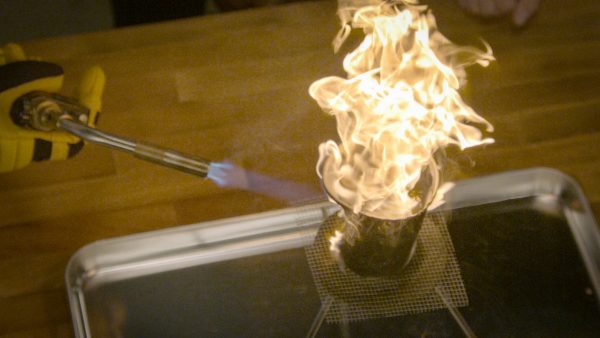Temperature Definition
Temperature measures the average kinetic energy of atoms in a substance. For example, higher readings on a thermometer indicate faster particle movement.
View Lesson on Heat: Transfer of Thermal Energy
Become a member to get full access to our entire library of learning videos, reading material, quiz games, simple DIY activities & more.
Become a member to get full access to our entire library of learning videos, quiz games, & more.
Plans & Pricingto watch this full video.

Access All Videos
and Lessons, No Limits.
Access All Videos

No credit card required,
takes 7 sec to signup.
No card required

Ready-to-go lessons
that save you time.
Ready-to-go lessons
If you are on a school computer or network, ask your tech person to whitelist these URLs:
*.wistia.com, fast.wistia.com, fast.wistia.net, embedwistia-a.akamaihd.net
Sometimes a simple refresh solves this issue. If you need further help, contact us.
Heat: Transfer of Thermal Energy
Fun Facts
- It takes more heat to raise the temperature of water than the temperature of metal.
- Temperature is not a property of particular materials. Materials exposed to the same conditions will have the same temperature.
- Temperature does not depend on size.
Why Do We Need To Know About Temperature
Learning about temperature helps us understand why it’s important to know how heat moves. For example, knowing why jackets keep us warm by not letting heat escape, or how emergency blankets keep body heat in, shows how temperature is used in making clothes and in first aid.
This knowledge is also used in things like solar cookers that cook food using the sun’s heat, and in everyday items like clothing irons. It’s important for flying planes, making computers, and studying the weather on other planets. Knowing about temperature is useful in many areas.
Frequently Asked Questions
Check out the Full Lesson on Heat: Transfer of Thermal Energy
In this lesson, we learn that:
- Heat is the transfer of thermal energy from one object to another.
- Heating can occur by conduction, convection and radiation.
- Some materials can store more thermal energy than others.
Related Topics
- Analog Signal Definition
- Biodiversity Definition
- Biomimicry Definition
- Biotechnology Definition
- Cell Definition
- Chemical Reaction Definition
- Comparative Anatomy Definition
- Conduction Definition
- Conductor Definition
- Convection Definition
- Definition Of Living Things
- Electric Charge Definition
- Energy Transfer Definition
- Engineering Definition
- Force Definition
- Frequency Definition
- Generator Definition
- Genetic Factors Definition
- Gravity Definition
- Heat Definition
- Igneous Rock Definition
- Keystone Species Definition
- Kinetic Energy Definition
- Life Cycle Definition
- Light Source Definition
- Limited Resource Definition
- Magnetism Definition
- Mitochondria Definition
- Molecule Definition
- Mutation Definition
- Natural Selection Definition
- Newton’s 1st Law Of Motion Definition
- Newton’s 2nd Law Of Motion Definition
- Opaque Definition
- Parasitism Definition
- Properties Of Matter Definition
- Property Definition
- Reflecting Surface Definition
- River Definition
- Senses Definition
- Simple Machines Definition
- Solar System Definition
- Temperature Definition
- Thermometer Definition
- Tissue Definition
- Unbalanced Force Definition
- Water Definition
- Water Erosion Definition
Start a Free Trial Today. Get a $5 Amazon Gift Card!
Teachers! Start a free trial & we'll send your gift card within 1 day. Only cards left. Try it now.
Select Grade
Select Subject
This email is associated with a Science Kit subscription. Kit subscriptions are managed on this separate page: Manage Subscription

-
Download InvoiceScience & Math$/yr
-
Download InvoiceScience Only$/yr

access all lessons
• No credit card required •
"My students loved the videos. I started the video subscription in May and used them as a review before the state test, which I know contributed to 100% of my class passing the state test."
Rhonda Fox 4th Grade Teacher, Ocala, Florida
Use Generation Genius in Your School
Access all lessons free for 30 days.
"My students loved the videos. I started the video subscription in May and used them as a review before the state test, which I know contributed to 100% of my class passing the state test."
Rhonda Fox 4th Grade Teacher, Ocala, Florida
• No credit card required •
Already a member? Sign In
* no credit card required *

* no credit card required *
* no credit card required *


to Discover the Benefits of Generation Genius
Learn How to Save for Your School & District!

no credit card required
Skip, I will use a 3 day free trial
Enjoy your free 30 days trial
-
Unlimited access to our full library
of videos & lessons for grades K-5. -
You won’t be billed unless you keep your
account open past your 14-day free trial. -
You can cancel anytime in 1 click on the
manage account page or by emailing us.
-
Unlimited access to our full library of videos & lessons for grades K-5.
-
You won't be billed unless you keep your account open past 14 days.
-
You can cancel anytime in 1-click on the manage account page.
Cancel anytime in 1-click on the manage account page before the trial ends and you won't be charged.
Otherwise you will pay just $10 CAD/month for the service as long as your account is open.
Cancel anytime on the manage account page in 1-click and you won't be charged.
Otherwise you will pay $10 CAD/month for the service as long as your account is open.
We just sent you a confirmation email. Enjoy!
DoneWe use cookies to make your experience with this site better. By using this site you agree to our use of cookies. Click "Decline" to delete and block any non-essential cookies for this site on this specific property, device, and browser. Please read our privacy policy for more information on the cookies we use.Learn More
We use cookies to improve your experience. By using this site, you agree to our use of cookies. Click "Decline" to block non-essential cookies. See our privacy policy for details.Learn More




























































































































